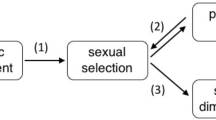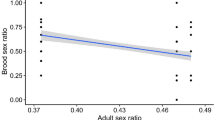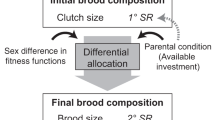Abstract
The idea that offspring sex ratio is affected by parental capacity for reproductive investment was first developed by Trivers and Willard1 and later elaborated by others2–6. According to this hypothesis, if the amount of parental investment7 differentially affects the expected reproductive success of offspring depending on offspring gender, then parents capable of exceptionally large investment should bias reproductive investment toward the sex affected most. For most polygynous mammals, male reproductive success is expected to be most enhanced by exceptionally large investment1,8, but observational field studies and laboratory experiments have either supported9–13 or contradicted3,14–16 this conditional sex-allocation hypothesis. We have performed the first experimental field study specifically to examine this hypothesis, and find that the female common opossum (Didelphis marsupialis), whose capacity for parental investment was artificially enhanced by dietary supplementation, produces male-biased sex ratios, in contrast to the unbiased ratios produced by control females.
This is a preview of subscription content, access via your institution
Access options
Subscribe to this journal
Receive 51 print issues and online access
$199.00 per year
only $3.90 per issue
Buy this article
- Purchase on Springer Link
- Instant access to full article PDF
Prices may be subject to local taxes which are calculated during checkout
Similar content being viewed by others
References
Trivers, R. L. & Willard, D. E. Science 179, 90–92 (1973).
Williams, G. C. Proc. R. Soc. B205, 567–580 (1979).
Altmann, J. Baboon Mothers and Infants (Harvard University Press, 1980).
Fiala, K. L. Evolution 35, 898–911 (1981).
Okansen, L. Am. Nat. 117, 109–111 (1981).
Charnov, E. L. The Theory of Sex Allocation (Princeton University Press, 1982).
Trivers, R. L. in Sexual Selection and the Descent of Man 1871–1971 (ed. Campbell, B.) 136–179 (Aldine, Chicago, 1972).
Clutton-Brock, T. H. & Albon, S.D. in Current Problems in Sociobiology (ed. King's College Sociobiology Group) 223–247 (Cambridge University Press, 1982).
Rivers, J. P. W. & Crawford, M. A. Nature 252, 297–298 (1974).
McClure, P. A. Science 211, 1058–1060 (1981).
Gosling, L. M. & Petrie, M. in Physiological Ecology (eds Calow, P. & Townsend, C. R.) 315–345 (Blackwell Scientific, Oxford, 1982).
Clutton-Brock, T. H., Albon, S. D. & Guinness, F. E. Nature 308, 358–360 (1984)
Rutberg, A. T. Am. Nat. 127, 89–94 (1986).
Verme, L. J. J. Wildl. Mngt. 47, 573–582 (1983).
Simpson, M. J. & Simpson, A. E. Nature 300, 440–441 (1982).
Silk, J. B. Am. Nat. 121, 56–66 (1983).
Sunquist, M. E., Austad, S. N. & Sunquist, F. J. Mammal. (in the press).
Petrides, G. A. J. Mammal. 30, 364–378 (1949).
Reynolds, H. C. Univ. Calif. Publs Zool. 52, 223–284 (1952).
Gardner, A. L. in Wild Mammals of North America (eds Chapman, J. A. & Feldhamer, G. A.) 3–36 (Johns Hopkins University Press, 1982).
Reiter, J., Stinson, N.L. & LeBoeuf, B.J. Behav. Ecol. Sociobiol. 3, 337–367 (1978).
Dittus, W. P. J. Behaviour 69, 265–301 (1979).
Maynard Smith, J. Behav. Ecol. Sociobiol. 7, 247–257 (1980).
Geist, V. Mountain Sheep (University of Chicago Press, 1971).
Clutton-Brock, T. H., Guinness, F. E. & Albon, S. D. Red Deer: Behaviour and Ecology of Two Sexes (Cambridge University Press, 1982).
Fleming, T. H. J. Mammal. 55, 543–561 (1974).
Kaufmann, J. H. Am. Zool. 14, 51–62 (1974).
Johnson, C. N. Austral. Wildl. Res. 10, 25–31 (1983).
Myers, J. H. Am. Nat. 112, 381–388 (1978).
Clutton-Brock, T. H., Albon, S. D. & Guinness, F. E. Nature 289, 487–489 (1981).
Author information
Authors and Affiliations
Rights and permissions
About this article
Cite this article
Austad, S., Sunquist, M. Sex-ratio manipulation in the common opossum. Nature 324, 58–60 (1986). https://doi.org/10.1038/324058a0
Received:
Accepted:
Issue Date:
DOI: https://doi.org/10.1038/324058a0
This article is cited by
-
Richardson’s ground squirrel litter size–sex ratio trade-off reveals conditional adaptive sex allocation
Oecologia (2021)
-
Variation in the sex ratio of pouch young and adult hairy-nosed wombats (Lasiorhinus latifrons and Lasiorhinus krefftii)
Behavioral Ecology and Sociobiology (2020)
-
Economics and evolutionary mismatch: humans in novel settings do not maximize
Journal of Bioeconomics (2016)
-
Secondary sex ratios do not support maternal manipulation: extensive data from laboratory colonies of spiny mice (Muridae: Acomys)
Behavioral Ecology and Sociobiology (2010)
-
Nutritional skewing of conceptus sex in sheep: effects of a maternal diet enriched in rumen-protected polyunsaturated fatty acids (PUFA)
Reproductive Biology and Endocrinology (2008)
Comments
By submitting a comment you agree to abide by our Terms and Community Guidelines. If you find something abusive or that does not comply with our terms or guidelines please flag it as inappropriate.



